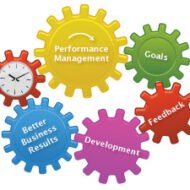Posted by Managementguru in Business Management, Organisational behaviour, Principles of Management, Training & Development
on Mar 1st, 2014 | 0 comments

Performance Appraisal Performance Appraisal is considered to be the most significant and indispensable tool for an organization. It is a measure of the employees’ performance levels in terms of the specific job’s requirement. It is a process employed for the purpose of placement, selection for promotions, providing financial rewards and other actions which require differential treatment among the members of a group. Purpose of Performance Appraisal Douglas McGregor says “Formal appraisal plans are designed to meet three needs, one of the organization’s and the other two of the individual namely, Performance appraisal methods facilitate systematic judgments to decide on the salary increases, transfers, demotions or terminations. They serve as a yard stick for an employee as to where he stands in the performance rating queue in the eyes of management and how he needs to adapt or improve himself regarding behavior, attitude, skills or job knowledge. They are used as a means to train and counsel each and every employee by the respective superiors. Performance appraisal can also be termed as Merit rating Behavioral assessment Employee evaluation Personnel review Progress report Staff assessment Service rating. According to Levinson, it definitely provides adequate feedback to each individual for his performance and also serves as a means for changing behavior. Prime Objectives of Performance Appraisal: Helps to maintain man power inventory of an organization which includes quantity and quality, to identify the training needs and aspirations of the work force. To determine increments and provide a reliable index in promotions and transfers to positions of greater responsibility. To improve individual as well as group development by determining the performance standard and motivating the employees to perform well. Providing support to employees who are not able to focus and to bring them back into the groove. The Process of Evaluation: Establishment of performance standards. Communicating the same to employees. Aquiring information through personal observation and statistical reports from the respective departments. Appraising and judging the future potential growth and advancement. Identifying the deviation between the actual and standard performance levels. Discussion with the employee for subsequent improvement or corrective action. Appraisal Summary: 1. Personnel Background covering the following details are collected Age Family background Marital status Children Education Specialization and degrees Office held Work history Social accomplishments Honors and awards Professional or trade organization membership Publications Special limitations Family problems Hobbies and recreational activities 2. Nature of Work: Job performance and personal qualification Technical performance Level of motivation in current position Intelligence as reflected on the job Emotional stability Leadership skills 3. Overall Performance Rating: Recommended action Knowledge Skill Attitude Methods of Performance Appraisal: Traditional methods: These rely upon evaluating an individual’s creativity, intelligence, drive, dependability, leadership potential, initiative and organizing capability which are more of personal in nature. Modern methods: These include ranking method, graphic rating scales, forced choice description method, critical incident and 360 degree evaluation methods. The 360 degree appraisal method is employed in big corporate companies where the individual’s overall performance is appraised by his colleagues, boss, customers, suppliers and stake holders. Management by objectives, management by exception , self appraisal and human asset accounting are other methods used for appraisal. Problems that may arise during performance appraisal: Halo Effect: It is a tendency to let the assessment of an individual’s any one trait to influence the evaluation of that person on other specific traits. The Central Tendency problem: It assigns average rating to all the employees in order to avoid commitment. Similarity error: This occurs when the evaluator evaluates other persons based on ‘self perception’, that is if he perceives himself to be adventurous or daring he may evaluate others looking for that same trait which he possesses. How to make appraisal successful? The superior must be well trained and a composed person to judge without...

Posted by Managementguru in Human Resource, Interview Questions, Principles of Management
on Feb 27th, 2014 | 0 comments

Interview Interesting Aspects An interview can be explained as a mutual conversation or a one to one meeting that gets stretched into a “recruitment process or promotion.” In French, from which it originates interview means ‘inter-sight’ and in Latin, it is interpreted as ‘seeing each other.’ Nowadays interview is a powerful tool in psychology, in the healthcare profession as well as in business. Too many approaches in the interviewing process may be successful as fact finding tools but without looking at the dynamics existing between an interviewer and interviewee; such meetings then become lifeless. The notion of an interview should not only aim at collecting scientific data but also look into the human aspect to capture the essence of a person. Only a trained interviewer must be allowed to evaluate the interviewee’s motivation, personality component and the influence of environmental/ emotional problems on him/her. The two common pitfalls in an interview are the ‘stereotyping’ of the individual and the unconscious exercise of personal bias. Is it wise to judge a person based on similarities to some other person/ trait? ‘Halo Effect’ is the tendency to judge a person based on one of a few specific characteristics- the traits liked or disliked by the interviewer need not be superimposed on the interviewee to decide if he is suitable for the job. All depends on the interviewer and his characteristics which help or hinder an interview from the interviewee’s view point. Care must be taken on the part of the interviewer not to conclude the interview in an abrupt manner and it is also necessary for him to create a favorable image for the company in the mind of the interviewee. The interview is not to be considered merely as a selection technique, but as a means of in- depth analysis that facilitates closer and enhanced communication. This approach is very much necessary for psychologists, teachers, managers, leaders and the like. Definition: The interview is a conversation with a purpose. There are three purposes. 1. Obtaining information– Collecting relevant data about the candidate’s background, training, education, experience and interests. 2. Giving information– Apprising the interviewee with the present position of the company, the future plans, specific job and the personnel. 3. Motivation– Instigating the candidate to join the company Advantages of Interview: Interviews prove as a better means to measure the ability and traits of a personality rather than through written tests or other techniques. It is easy to determine how a person reacts in a conversation and whether he is good looking (here it means if he/ she is presentable, looks are equally important). A skilled interviewer can easily determine the personality traits such as loyalty and responsibility that can be expected from the candidate during this personal meeting. Limitations of Interview: · Stereo typing · Halo Effect · Personal bias Interviewing Techniques: A. Patterned Interview: This was developed by Mc. Murry. Senior recruitment, promotion and appraisal interviews fall under this category. This patterned interview contains no questions related to ‘job skills’. Basically it is conducted to appraise personality, motivation and interests. Reference checks and academic records determine knowledge and job competencies. The following personality traits could be measured through patterned interview according to Mc. Murry: i. Stability ii. Ability to get along with others iii. Self-reliance iv. Willingness to accept responsibility v. Freedom from emotional immaturity vi. Motivation B. Directive Style: This type of interview is appropriate when the interviewer seeks factual information only where the interviewee is not given much freedom of expression and so becomes defensive. There are also chances that the relationship between the interviewer and the interviewee might be impaired. C. Non-Directive Style: This requires more time, and suitable for exploring sensitive matters, understanding feelings and...




